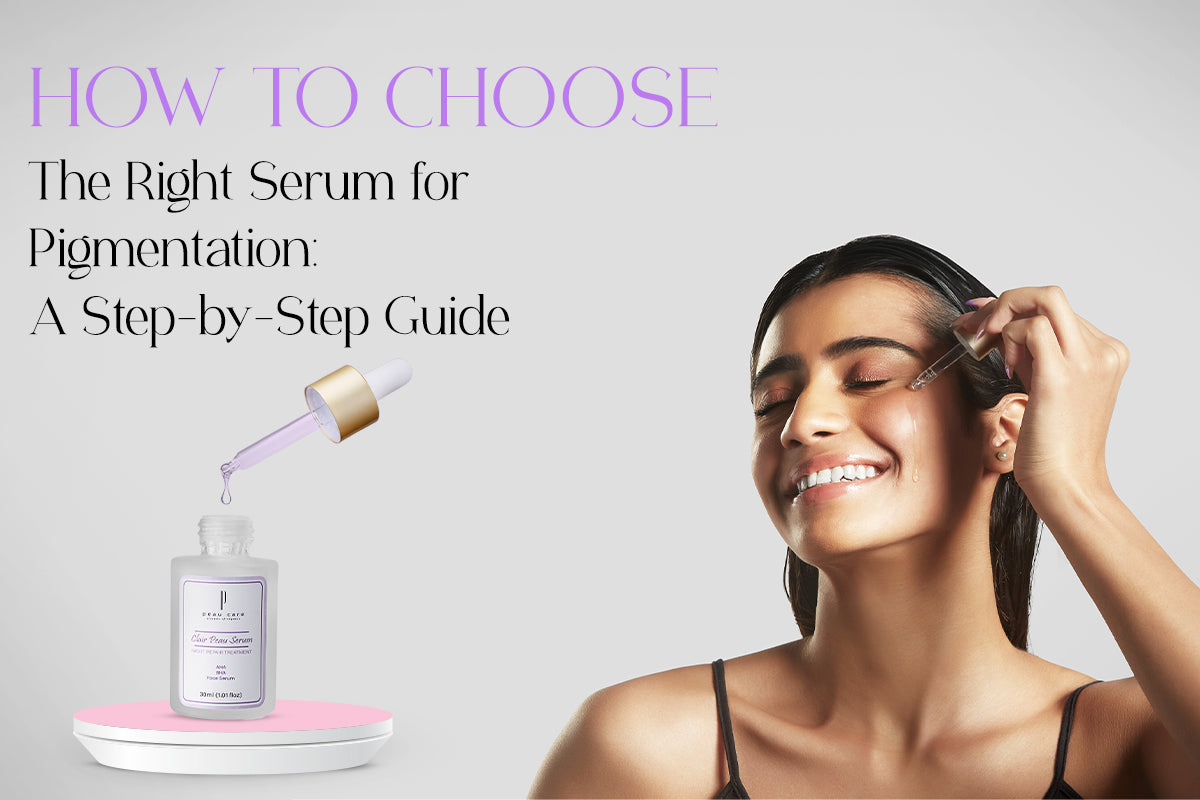
How to Choose the Right Serum for Pigmentation: A Step-by-Step Guide
Are you bothered by pesky pigmentation spots? Do you find yourself searching the internet for the best way to balance out your skin tone? Look no further! Choosing the appropriate pigmentation serum can significantly improve your skincare routine. However, with so many options available, choosing the right one might be difficult. But don't worry, we have you covered with our step-by-step guide to assist you in navigating the maze of pigmentation serums.
Step 1: Identify Your Skin Type
Before delving into the world of pigmentation serums, it's essential to know your skin type. Whether you have oily, dry, combination, or sensitive skin, there's a serum out there tailored to address your specific needs. For instance, if you have oily skin, look for keywords like " best face serum for oily skin " or if you have dry skin you can search for “best creams for face dryness” as few creams work wonders for dry skin and in this way you’ll narrow down your options.
Step 2: Understand Your Pigmentation Issues.
Not all pigment is created equally. Understanding your pigmentation difficulties, including such as dark patches, sun damage, or post-inflammatory hyperpigmentation, will help you select the most effective pigmentation serum. To treat various types of pigmentation, look for substances such as vitamin C, niacinamide, and alpha hydroxy acids (AHAs).
Step 3: Research key ingredients.
Once you've recognized your pigmentation concerns, it's time to explore the world of skincare ingredients. Look for serums that have powerful chemicals that have been shown to brighten and fade pigment. Vitamin C is a potent component that not only brightens the skin but also helps remove dark spots and balance skin tone. Niacinamide, or vitamin B3, is another effective component for decreasing pigmentation and improving skin texture. Furthermore, substances such as kojic acid, liquorice extract, and alpha hydroxy acids (AHAs) can help counteract pigmentation.
Step 4: Check for Additional Benefits.
While the primary purpose of a pigmentation serum is to correct uneven skin tone and dark patches, several formulas provide additional skin health advantages. Look for serums with antioxidants to protect the skin from environmental damage, as well as chemicals that boost collagen formation for a plump, young complexion.
Step 5: Seek Professional Advice if Necessary
If you're unsure about which pigmentation serum is right for you, don't hesitate to seek advice from a skincare professional. Dermatologists and estheticians can assess your skin type, concerns, and goals, providing personalized recommendations tailored to your individual needs.
Step 6: Evaluate Product Texture and Consistency
The texture and consistency of a serum play a significant role in its efficacy and how well it suits your skin type. For oily skin, lightweight, water-based serums are ideal as they provide hydration without adding excess oil. Look for terms like "oil-free" or "non-comedogenic" to ensure the serum won't clog pores. Conversely, those with dry skin should opt for richer, creamier formulations that offer intense hydration and nourishment.
Step 7: Consider your budget.
Skincare products are available at a variety of price points, so consider your budget while selecting a pigmentation serum. While some serums are more expensive, there are still affordable ones that produce excellent results. Remember that investing in skincare is an investment in the health of your skin, so choose a serum that is both affordable and effective.
Step 8: Read reviews and testimonials.
Before making a purchase, check the reviews and testimonies of other consumers who have used the product. Look for testimonials from people who have similar skin conditions and kinds to get a sense of how well the serum works for you. Be aware of any potential side effects or allergic reactions indicated in the reviews, and proceed with caution if you have sensitive skin.
Step 9: Step 3: Consider your skin sensitivity.
While powerful chemicals like AHAs and vitamin C can perform wonders for pigmentation, they can also cause discomfort in some people, especially those with sensitive or reactive skin. If you fall under this category, choose softer formulations or conduct a patch test before introducing a new serum into your skincare routine.
Step 10: Patch Test
After you've short-listed your alternatives and found a serum that seems promising, it's time to patch test. Apply a small amount of the serum to a discreet part of your skin, such as behind your ear or on your inner wrist, and wait 24-48 hours to observe if there are any adverse responses. If your skin tolerates the serum then you are good to go, you can add it to your regular skincare routine.
Conclusion: Choosing a suitable pigmentation serum does not need to be overwhelming. By following these step-by-step instructions and taking into account aspects like skin type, important components, and product reputation, you can confidently choose a serum that will reduce black spots, even out skin tone, and reveal a beautiful complexion. Remember that consistency is crucial, so integrate your selected serum into your daily skincare routine and watch your pigmentation issues fade away.
With the right pigmentation serum from the right brand such as Peau Care by your side, you can embark on a journey towards brighter, more luminous skin, leaving behind the shadows of pigmentation for good.

Leave a comment
This site is protected by hCaptcha and the hCaptcha Privacy Policy and Terms of Service apply.